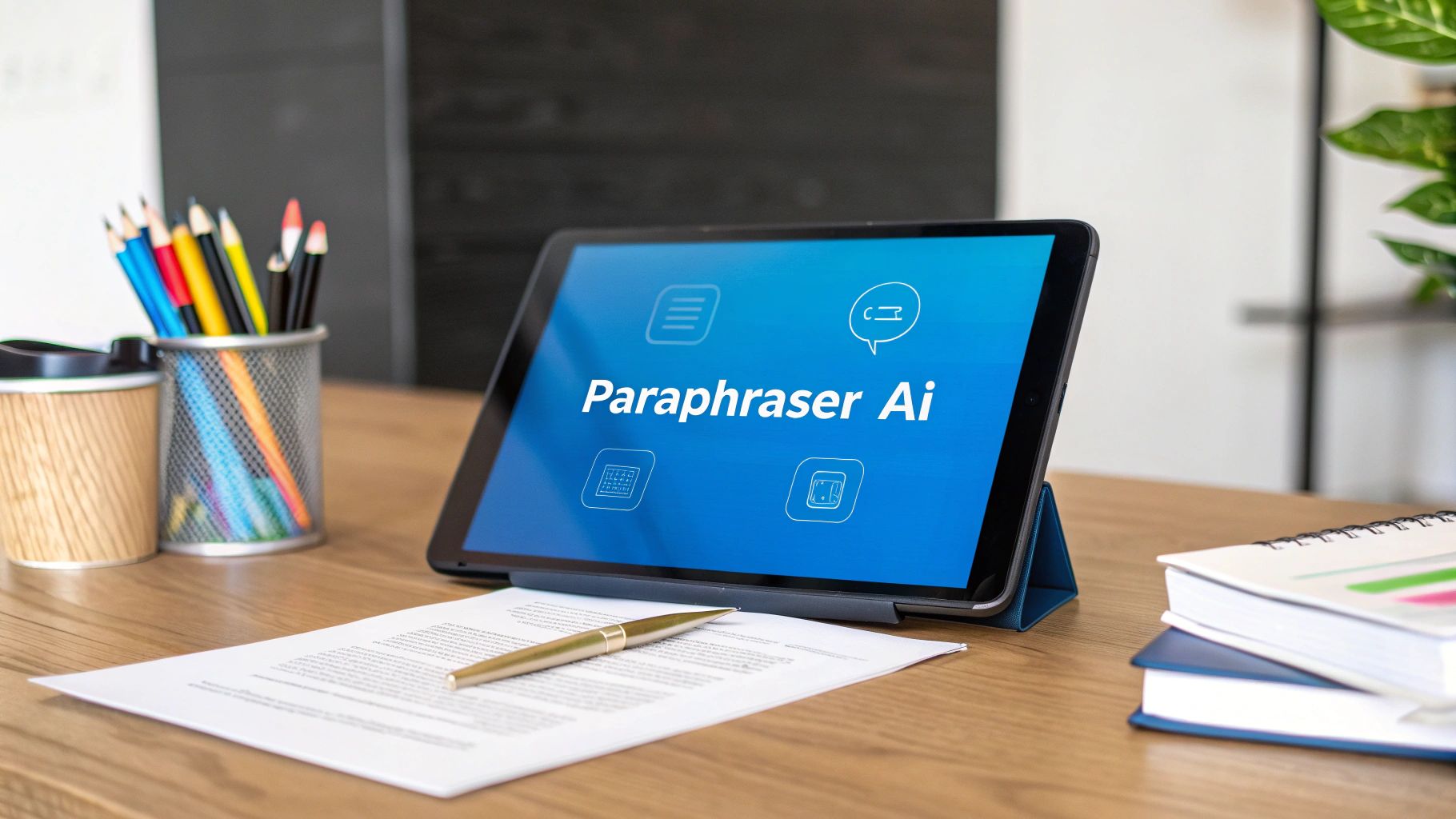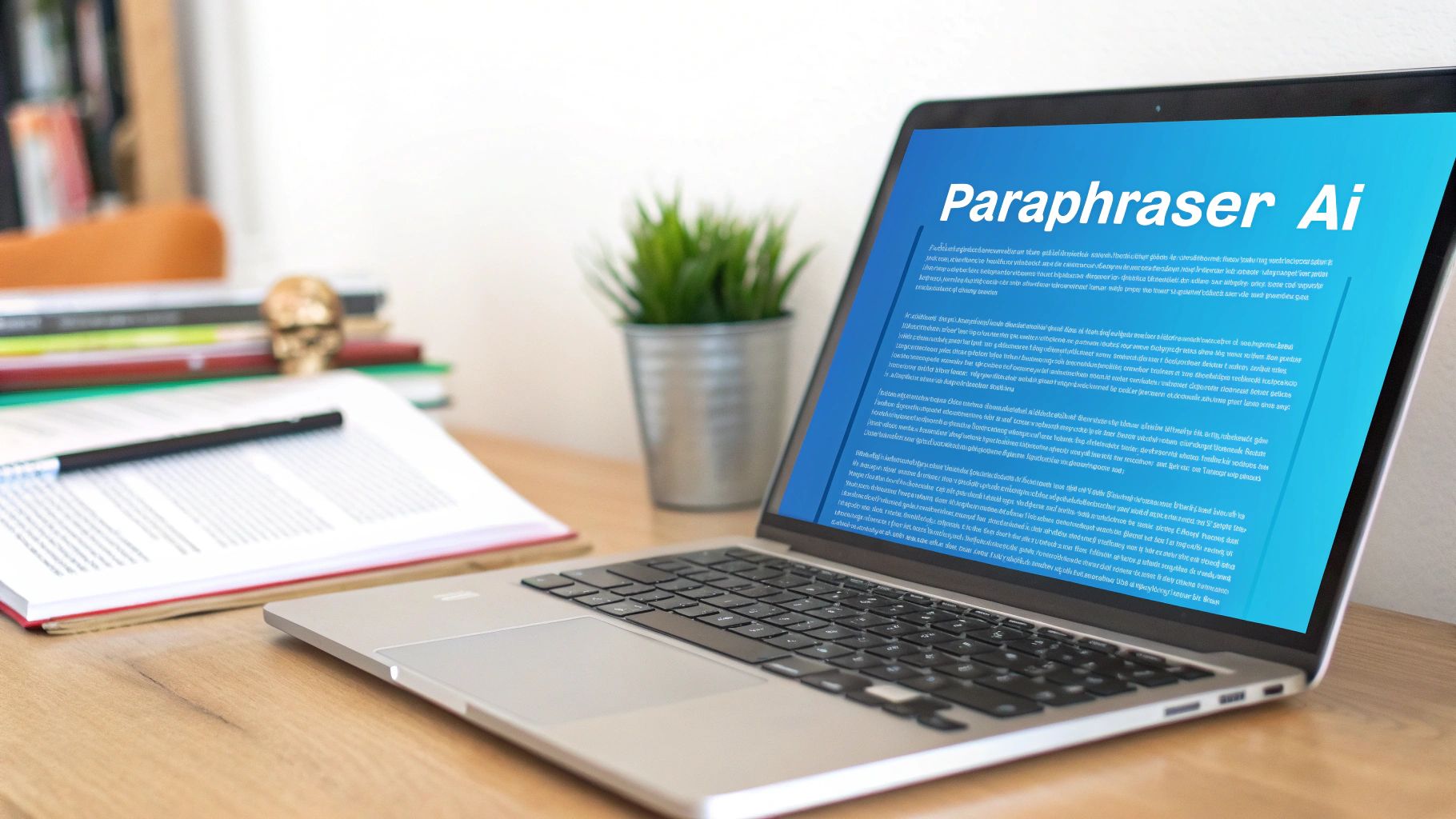What Is a Paraphraser AI and How Does It Work?

Ever stared at a sentence, knowing there’s a better way to say it, but the right words just won't come? That’s exactly where a paraphraser AI steps in. Think of it as a smart writing assistant that does much more than just swap out a few words.
What Exactly Is a Paraphraser AI?
A paraphraser AI isn't just a fancy thesaurus that replaces "happy" with "joyful." It’s more like a skilled editor who reads your work, truly gets the message you want to send, and then rebuilds it from the ground up for better clarity and flow.
To put it another way, imagine you're building with LEGOs. A basic synonym tool just swaps one red brick for another. A real paraphraser AI takes your entire creation, understands you’re trying to build a house, and then uses a new design with different bricks to build a stronger, more interesting house that still serves the exact same purpose. This is all powered by sophisticated algorithms that analyze grammar, context, and meaning.
Beyond Simple Word Swapping
The real magic behind modern paraphrasing tools is their ability to understand language on a much deeper level. They don't just see individual words; they recognize the relationships between them. This awareness of context allows them to handle complex tasks that are crucial for high-quality writing.
Here’s what a good one is really doing:
- Reworking Sentences: It completely rearranges sentence layouts. It can turn passive voice into active, or combine short, choppy sentences into a single, more elegant one.
- Keeping the Core Meaning: The tool makes sure the main point—the who, what, where, and why of your message—remains perfectly intact, even after the text has been transformed.
- Improving Vocabulary: It intelligently suggests a wider range of words that actually fit the specific context, making your writing more dynamic and engaging.
Who Is It For and Why Does It Matter?
At its heart, a paraphraser AI is a tool for anyone who needs to communicate clearly and originally. It’s not about cutting corners; it’s about elevating your work efficiently. For a student, it can be the difference between an essay flagged for accidental plagiarism and one that showcases genuine understanding. For a marketer, it means creating ten unique social media posts from a single core idea in just minutes.
The real power of a paraphraser AI is how it bridges the gap between a rough idea and a polished, ready-to-publish final draft. It saves countless hours of manual editing while boosting the quality of your content.
For instance, a blogger can feed an old post into a paraphrasing tool and get a fresh, updated article that can be republished without getting hit with a search engine penalty. A non-native English speaker can write out their thoughts and use the tool to refine them into fluent, natural-sounding prose. It’s a powerful ally for anyone who needs to produce clear, original, and impactful writing, time and time again.
How AI Tools Rewrite and Understand Language
To really get what a paraphraser AI can do, it helps to peek under the hood and see how it actually “thinks.” It isn't magic; it’s a brilliant technology called Natural Language Processing (NLP). Think of NLP as the AI's brain—it’s the system that lets a machine read, interpret, and make sense of human language in all its messy, nuanced glory.
When you hand a paraphrasing tool a piece of text, it does far more than just scan for keywords. It kicks off a sophisticated three-step process to first deconstruct your message and then rebuild it with fresh clarity and style. This is what separates a truly helpful tool from a basic word-swapper.
The Brain of the Machine: Natural Language Processing
At its core, Natural Language Processing is the branch of artificial intelligence focused on closing the communication gap between people and computers. NLP models are trained on massive datasets—we’re talking billions of sentences from books, articles, and websites—which allows them to learn the patterns, rules, and rhythms of human expression.
This training helps the AI move beyond simple dictionary definitions and get a feel for the subtle art of communication. The goal isn't just to recognize words but to understand the intent behind them. It’s the difference between knowing the word "fire" and figuring out if someone is shouting it as a warning or just asking for a lighter.
Step 1: Semantic Analysis
The first thing a paraphraser AI does is figure out the meaning of your text. In technical terms, this is called semantic analysis. It dissects each sentence to understand the role every word plays and how they all relate to one another.
- Finding the core message: The AI pinpoints the main subject, the action being taken, and whatever is receiving that action.
- Understanding context: It looks at surrounding words to lock in the right meaning. For example, the word "bank" means something totally different in "river bank" than it does in "savings bank."
- Recognizing sentiment: The tool can even pick up on the emotional tone of the text—whether it's positive, negative, or neutral.
This deep level of comprehension ensures that when the rewriting starts, your original message doesn't get lost or twisted.
Step 2: Syntactic Restructuring
Once the AI understands what you’re trying to say, it moves on to syntactic restructuring. This is where it acts like a creative architect, redesigning the sentence's blueprint while keeping the foundation solid. It starts exploring different ways to express the same core idea.
A key function of a high-quality paraphraser AI is its ability to break free from the original sentence structure, creating a new piece of text that is genuinely unique.
This involves a few clever techniques:
- Changing sentence order and how clauses are arranged.
- Switching from active to passive voice, or the other way around.
- Combining short, choppy sentences into a smoother one or breaking down long, complex sentences for clarity.
Step 3: Contextual Word Choice
The final step is perhaps the most impressive: contextual word choice. Drawing from its huge vocabulary and its grasp of nuance, the AI hand-picks new words that fit perfectly into the rebuilt sentence. It doesn't just look for synonyms; it considers the formality, tone, and specific context of your topic.
For instance, if the original text says, "The new policy made the employees mad," a basic tool might spit out, "The new rule made the workers angry."
But a more advanced paraphraser AI would offer smarter options based on the tone you need. You might get, "The recent policy caused significant frustration among the staff," for a formal report, or, "Team morale took a hit after the new directive was announced," for an internal memo. This ability to make content sound natural is crucial. It's also important to understand how these tools work across different languages, and for a deeper look, you can explore whether AI detection can spot translations in our guide. This level of refinement makes sure the final output is not only original but also perfectly tuned for its intended audience.
Key Features of a High-Quality Paraphraser AI
As the world of AI writing tools expands, it’s become crystal clear that not all paraphrasers are built the same. A basic tool might just shuffle some words around and call it a day. But a high-quality paraphraser AI is different—it’s a powerful partner with a whole suite of features designed to make your writing not just different, but genuinely better.
The best tools act like versatile assistants, adapting to whatever you throw at them. They go way beyond simple text swaps, giving you sophisticated controls over the final output. Think of it less like a vending machine spitting out a pre-set option and more like a fully stocked kitchen, giving you the ingredients and tools to craft the perfect message.
Multiple Writing Modes for Any Occasion
A top-tier paraphraser AI knows there’s no such thing as a one-size-fits-all solution. The way you write an academic paper is worlds apart from how you’d craft a quick social media post. That's why the best platforms offer multiple writing modes.
These modes are essentially pre-set styles that tell the AI how to rewrite your text for a specific purpose. Some of the most common and useful modes include:
- Formal: This setting tightens things up with professional language, ditches contractions, and structures sentences for a serious, official tone. It's perfect for business reports or important client emails.
- Creative: This mode lets the AI get more expressive, using descriptive language and unique phrasing to tell a story or sell an idea. It’s ideal for marketing copy or personal blog posts.
- Academic: Built for research papers and essays, this mode prioritizes clarity, precision, and a scholarly voice, helping you structure complex arguments logically.
Having these options at your fingertips saves you the headache of manually tweaking a generic output to fit your needs.
As you can see, a good paraphrasing tool doesn't just do one thing. It's built to tackle two of the biggest challenges in writing: speeding up your workflow and ensuring your final text is completely original.
When you're choosing a tool, having a clear idea of the essential features can make all the difference. Here’s a quick breakdown of what to look for.
Essential Features of a Modern Paraphraser AI
| Feature | Why It Matters | Impact on Your Content |
|---|---|---|
| Multiple Writing Modes | Provides instant versatility for different writing tasks. | Adapts text for formal, creative, or academic contexts without manual editing. |
| Humanizing Capabilities | Prevents content from sounding robotic and flat. | Infuses text with natural rhythm and nuance, making it engaging and authentic. |
| AI Detection Evasion | Crucial for avoiding flags from AI checkers like Turnitin. | Creates content that reads as human-written, preserving its integrity. |
| Integrated Plagiarism Checker | Offers an all-in-one solution for ensuring originality. | Gives you peace of mind that your work is 100% unique before you publish. |
Looking for these key features ensures you’re not just getting a simple spinner, but a comprehensive writing assistant that truly elevates your work.
The Power to Humanize and Bypass AI Detection
In today's content-driven world, authenticity is king. One of the most critical features of a modern paraphraser AI is its ability to humanize text. We’ve all seen it—AI content that feels robotic, with clunky sentence structures and a lifeless tone. The advanced tools are engineered specifically to fix this.
A key differentiator for a superior paraphrasing tool is its ability to produce content that reads as if it were written by a person, making it virtually undetectable by AI checkers.
This "humanizing" process isn't just about swapping synonyms. It's about:
- Varying sentence length and structure for a natural rhythm.
- Introducing idioms and more nuanced vocabulary.
- Maintaining a consistent and believable tone of voice.
This is exactly where a tool like Word Spinner shines. Its advanced algorithms don't just rewrite text; they infuse it with a natural, human quality that helps bypass AI detection and guarantees 100% plagiarism-free output. This is absolutely essential for anyone creating content for SEO, submitting academic work, or delivering projects to clients where authenticity is non-negotiable.
Integrated Plagiarism Checking for Peace of Mind
Finally, a first-class paraphrasing tool should help you protect your professional and academic integrity. The whole point of paraphrasing is to create original work, and a built-in plagiarism checker acts as an essential safety net.
Instead of having to copy your text into a separate tool, the best platforms build this function right into the workflow. After the AI has done its magic, you can instantly run a plagiarism scan. This guarantees your new content is 100% unique and free from any accidental overlap with other sources. It’s the final step that gives you the confidence to hit publish or submit your work without a second thought.
To explore the different options out there, check out our guide on what is the best AI tool to rewrite text and find the perfect fit for your needs.
The Growing Role of AI in Modern Content
To really get why an AI paraphraser is such a big deal, it helps to step back and look at the bigger picture. Artificial intelligence isn't some far-off concept anymore; it's right here, woven into the fabric of modern business, especially when it comes to creating content and marketing. It’s no longer an interesting gadget but a must-have tool for anyone serious about staying competitive.
The simple truth is that companies embracing AI are sprinting ahead, leaving others in the dust. This isn't just about working faster; it's about gaining a serious strategic edge. From automating the boring, repetitive tasks to digging up deep insights about what audiences want, AI is fundamentally reshaping how we work.
The Explosive Growth of the AI Market
This shift toward AI isn't just a hunch—it's backed by some staggering numbers. The global artificial intelligence market, which includes powerful tools like AI paraphrasers, was valued at a massive $233.46 billion in 2024. Projections show it skyrocketing to over $1.77 trillion by 2032, thanks to a compound annual growth rate of 29.2%. North America is currently leading the charge, holding about 32.9% of the market share, fueled by huge investments and a high concentration of AI companies. For a closer look at these figures, you can dive into the full report on the artificial intelligence market.
These numbers paint a very clear picture: AI isn't a passing trend. It's a foundational economic force. Businesses are definitely taking notice, with around 35% having already brought AI into their operations and a whopping 90% of organizations using it to stay competitive. This widespread adoption shows that a paraphraser AI isn't some niche product; it's part of a massive technological wave.
Understanding this market shift is key. Using an AI tool isn't just about tweaking a single piece of text; it's about plugging into a smarter, faster, and more effective way of creating content that is quickly becoming the new normal.
Why This Shift Gives You a Competitive Advantage
So, what does all this market growth mean for you as a content creator, student, or professional? It means that using tools like a paraphraser AI gives you a real, measurable advantage. While your competition is stuck spending hours manually editing and rewording their work, you can get better results in just a fraction of the time.
This advantage really comes down to a few key areas:
- Speed and Scale: You can churn out more high-quality content faster than ever before. This is a game-changer for marketers who need a steady stream of fresh blog posts, social media updates, and ad copy.
- Improved Quality: The best AI tools can elevate your writing by suggesting more precise words and varied sentence structures. This helps you communicate your ideas with more clarity and impact.
- Originality and Authenticity: With so much AI-generated content floating around, being able to create unique, human-sounding text is more valuable than ever. Tools that can humanize content and fly under the radar of AI detection are essential for keeping your credibility intact.
For anyone creating content today, knowing how to produce text that feels authentic is vital. We’ve got some practical tips on this in our guide on how to effectively bypass AI detection. At the end of the day, embracing a paraphraser AI is all about working smarter, not harder, and setting yourself up to succeed in a world where AI-powered creation is the new standard.
Best Practices for Using a Paraphraser AI
Getting your hands on a powerful paraphraser AI is just the first step. To really see exceptional results, you need to be smart about how you use it. It's less about blind automation and more about intelligent collaboration. Think of it as having a junior writer on your team—they're incredibly fast and talented, but they still need your expert eye to guide them toward a masterpiece.
This guide will give you some actionable tips to move beyond just clicking a button. We'll get into why the quality of your source text is so critical and how you can refine the AI's output to make sure the final piece is original, authentic, and sounds perfectly like you.
Start with High-Quality Source Material
The most important rule for using a paraphraser AI is simple: garbage in, garbage out. The AI's output is always a direct reflection of the quality of the text you feed it. If you give it a confusing, poorly written, or vague sentence, you can bet you’ll get a confusing, poorly written, or vague result back.
Before you even think about paraphrasing, take a second to look over your source text. Is the message clear? Do the ideas flow logically? A well-written starting point gives the AI a solid foundation to build on, which dramatically improves the quality of its suggestions.
For instance, a great way to use these tools is by utilizing existing content formats like PLR products. A clear, well-structured PLR article will give you a much better rewritten version than a jumbled mess ever could.
Treat It as an Assistant, Not a Replacement
One of the biggest mistakes people make is treating a paraphraser AI as a total replacement for their own thinking. This tool is a powerful assistant, not a ghostwriter. Its job is to generate options and speed up your workflow, but the final judgment and creative direction have to come from you.
Think of it like a brainstorming partner. The AI can toss out dozens of great ideas—new sentence structures, better word choices, or different angles on a point. Your job is to step in as the editor, picking the best suggestions and weaving them together into something cohesive and compelling.
Never blindly accept the first output. The real magic happens when you combine the AI’s speed and versatility with your own human expertise and insight. This partnership is what produces truly outstanding content.
This collaborative approach is what keeps your final work authentic. It's a process of guided creation, where you're the one steering the technology to hit your specific goals.
Review and Refine with Your Unique Voice
Once the AI generates a new version of your text, your work isn’t done—it’s just getting started. This is the crucial review and refinement stage, where you get to infuse the content with your unique voice, perspective, and style.
The AI gives you the raw materials; you provide the finishing touches. Read through the paraphrased text and ask yourself a few questions:
- Does this sound like me? Tweak the phrasing until it matches your natural tone and rhythm.
- Is the meaning precise? Adjust any words or sentences that don't perfectly capture what you want to say.
- Could I add a personal story or example here? Injecting your own experiences is what makes content relatable and real.
This final editing pass is what elevates a good piece of content into a great one. For students, this step is especially important for maintaining academic integrity. If you're curious about the ethics, you can find helpful insights by exploring the question of whether using AI for essays is cheating in our detailed guide.
By following these best practices, you can use a paraphraser AI to not only save time but also to sharpen your writing, push your creative boundaries, and produce work that is both original and undeniably yours.
Common Questions About Paraphraser AI Tools
As you start exploring what a paraphraser AI can do, it’s only natural for a few questions to pop up. People often wonder about originality, practical uses, and the ethics of it all. Getting straight answers is the best way to start using these tools with confidence.
Think of this as your go-to guide for navigating the world of AI-powered writing. We'll tackle the most common questions head-on so you can get the most out of these powerful assistants while keeping your work top-notch.
Is Using a Paraphraser AI Considered Plagiarism?
This is the big one, and the answer is a clear no—as long as you use a high-quality paraphraser AI responsibly. Plagiarism is when you steal someone else's work or ideas and try to pass them off as your own. A good paraphrasing tool is actually designed to help you avoid that exact problem.
It works by completely rebuilding sentences with new vocabulary to express the original idea in a totally unique way. But that doesn't let you off the hook. The goal is to rephrase information to make it clearer or more original, not to claim the underlying concept is yours.
Crucially, if you're writing for school or work, you must always cite the original source of the concept or data, even after you've paraphrased it. The tool gives you new words, but the idea still belongs to the person who came up with it.
Can AI-Paraphrased Content Be Detected?
Content churned out by basic or free paraphrasing tools can definitely get flagged by AI detectors. Those checkers are built to spot the tell-tale signs of low-quality AI: robotic sentence structures, predictable word choices, and an unnatural, clunky flow.
This is where advanced tools make all the difference. The best platforms, like Word Spinner, are engineered specifically to "humanize" the text. They do this by:
- Varying sentence length and structure to create a more natural rhythm.
- Using a richer, more nuanced vocabulary that sounds like a real person wrote it.
- Maintaining a consistent and believable tone from start to finish.
This sophisticated approach produces an output that’s much harder to tell apart from something written by a human. That significantly lowers the odds of it getting flagged by AI detection software, which is a must for anyone whose work needs to feel authentic and pass originality checks.
Who Benefits Most From a Paraphraser AI?
Honestly, the audience for a paraphraser AI is massive because it solves a problem almost everyone with a keyboard faces: the need to create clear, original content without spending all day on it.
- Students use it to get a better grip on complex topics and make sure their essays are free from accidental plagiarism.
- Content marketers and bloggers rely on it to pump out unique articles, social media updates, and ad copy at scale, which is perfect for keeping their content calendars packed.
- SEO professionals can repurpose existing content for different platforms without getting hit with penalties from search engines for duplicate content.
- Non-native English speakers use it to polish their writing, which helps improve their fluency and makes their communication sound much clearer and more professional.
At the end of the day, it's a game-changer for anyone who writes.
Ready to see what next-level writing assistance feels like? Give Word Spinner a try and discover how effortless great writing can be.



